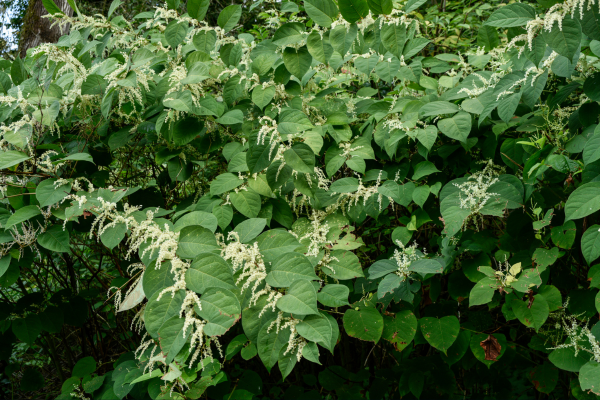In case you missed it see what’s in this section
Let's Talk
Your Total Guide To lifestyle

The Invasive Nature of Japanese Knotweed: Causes and Effects
Japanese Knotweed (Fallopia japonica) is a seemingly innocuous plant that has garnered notoriety for its invasive nature, causing havoc in gardens, landscapes, and ecosystems worldwide.
Originally introduced as an ornamental plant in the 19th century, Japanese Knotweed has since become a persistent and problematic invader, threatening native biodiversity, infrastructure, and property values. In this blog post, we will explore the causes and effects of Japanese Knotweed's invasive behavior, shedding light on the ecological and economic implications of this invasive species.
Causes of Invasion
- Rapid Growth and Reproduction:
One of the primary reasons for Japanese Knotweed's invasive success is its ability to grow rapidly and reproduce prolifically. This plant can grow up to 10 centimeters per day during its peak growing season, quickly forming dense stands that outcompete native vegetation. Additionally, Japanese Knotweed can reproduce through both seeds and vegetative propagation, allowing it to spread vigorously.
- Lack of Natural Predators:
Japanese Knotweed faces minimal herbivore pressure in its non-native habitats. In its native range, various insects and pathogens help keep its population in check. However, these natural predators are generally absent in new environments, allowing the plant to grow unchecked.
- Resilience to Environmental Stressors:
Japanese Knotweed has demonstrated remarkable resilience to various environmental stressors, including pollution, soil compaction, and extreme weather conditions. This adaptability enables it to thrive in a wide range of habitats, making it a formidable invader in both urban and natural settings.
Effects of Invasion
- Ecological Impact:
The spread of Japanese Knotweed can have devastating consequences for native ecosystems. Its rapid growth and dense stands shade out native plants, reducing their ability to photosynthesize and reproduce. This displacement disrupts the balance of the ecosystem and threatens the survival of native flora and fauna. In some cases, Japanese Knotweed can even alter soil chemistry, further exacerbating its impact on native vegetation.
- Property Damage:
Japanese Knotweed is not limited to natural areas; it can also wreak havoc on urban landscapes. Its powerful root system can penetrate foundations, driveways, and even water pipes, causing costly damage to buildings and infrastructure. The presence of Japanese Knotweed on a property can significantly reduce its value, making it difficult to sell or secure financing.
- Economic Costs:
The economic costs of Japanese Knotweed invasion are substantial. Governments, businesses, and homeowners spend millions of dollars annually on efforts to control and eradicate this invasive species. These control measures include herbicide treatments, excavation, and disposal of plant material, all of which come with significant expenses.
- Legal Consequences:
In some regions, landowners are legally obligated to manage Japanese Knotweed on their properties to prevent its spread. Failure to do so can result in fines and legal action. This legal burden adds to the overall economic impact of Japanese Knotweed invasion.
Control and Mitigation Efforts
Efforts to control and mitigate the invasive nature of Japanese Knotweed have been ongoing for many years. While complete eradication is challenging, several strategies have proven effective:
- Chemical Control:
Herbicides, when applied correctly, can effectively control Japanese Knotweed. Professional applicators can administer targeted treatments to minimize damage to non-target species and the environment.
- Mechanical Control:
Mechanical methods, such as cutting, mowing, or excavation, can be used to manage Japanese Knotweed. However, these methods may require multiple treatments and rigorous follow-up to ensure successful control.
- Biological Control:
Introducing natural enemies, such as insects or pathogens that feed on Japanese Knotweed, is being explored as a long-term control strategy. However, the implementation of biological control measures requires careful consideration to prevent unintended consequences.
In the UK, where the invasive Japanese Knotweed is a significant concern, these control and mitigation efforts are crucial for safeguarding both natural ecosystems and human-built environments. By employing these strategies effectively, KnotweedUK can work towards reducing the impact of this invasive plant and preserving the health and stability of local ecosystems and communities.
Conclusion
Japanese Knotweed's invasive nature is a growing concern worldwide, impacting both natural ecosystems and human-built environments. Its rapid growth, lack of natural predators, and resilience to environmental stressors have allowed it to establish a formidable presence in non-native habitats. The effects of this invasive species are far-reaching, causing ecological disruptions, property damage, economic costs, and legal consequences.
Efforts to control Japanese Knotweed continue to evolve, with various methods being employed to manage its spread and mitigate its impact. However, successful management requires a concerted and ongoing effort from individuals, communities, and governments.
Weather in Manchester
Listings











